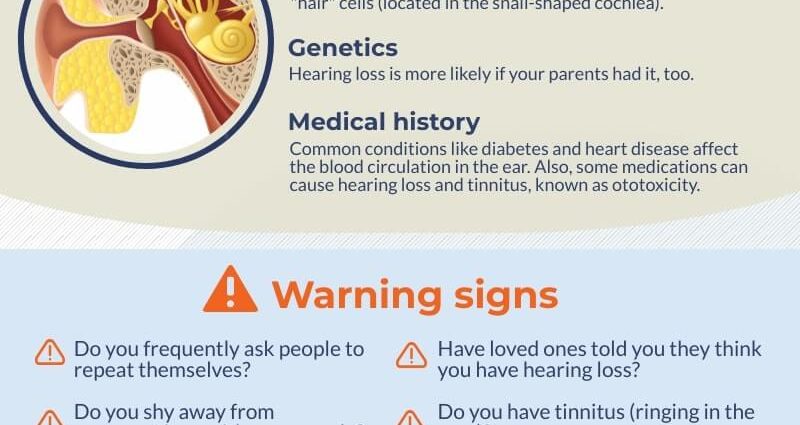Contents
Senile deafness is a consequence of the natural aging process of the nervous, receiving and hearing organs. The first symptoms of this type of hearing impairment can be diagnosed as early as between the ages of 20 and 30. A typical symptom of advanced senile deafness is difficulty understanding speech. General treatment is based on the administration of preparations that inhibit the aging process of the body and improve circulation in the inner ear.
Definition of senile deafness
Age-related deafness is an age-related condition. It consists in the gradual loss of hearing, which is usually a physiological process of aging in the body. A characteristic symptom of this ailment is the difficulty in understanding speech. When talking about senile deafness, one should classify it into:
- Conductive hearing loss – may result from pathology of the external auditory canal or poor operation of the ossicles, which transmit vibrations from the outer to the inner ear;
- sensorineural hearing loss – characterized by disturbances in the part of the ear responsible for receiving acoustic waves (the cochlea or the nerve part of the hearing organ);
- mixed hearing loss – combines the two above-mentioned types of hearing loss in one hearing organ.
Usually, senile deafness is associated with sensorineural disorders.
The causes of senile deafness
It is generally accepted that senile deafness is associated with progressive age and other factors that are difficult to define unequivocally. However, there are two similar opinions about the causes of senile deafness.
1. Some people believe that deafness is related only to the aging process.
2. According to others, senile deafness occurs not only due to age, but also due to noise, injuries and ototoxic drugs.
However, among the factors influencing the severity of senile deafness and the speed of the procedure are:
- injuries,
- diabetes,
- prolonged exposure to noise,
- atherosclerosis,
- general aging
- hypertension,
- listening to loud music (especially through headphones placed in the ears),
- obesity,
- genetic factors,
- the use of aminoglycoside antibiotics, loop diuretics, macrolide diuretics and non-steroidal anti-inflammatory drugs – having an ototoxic effect.
Symptoms of senile deafness
Age-related deafness is not a sudden and unexpected condition. It is a long process that can take place over several dozen years, which is why it is so often overlooked. Usually it happens that people from the patient’s closest circle notice hearing problems when fluent communication is disturbed. It happens that the elderly are nervous and raise their voices, and it is much more difficult to perceive stimuli from the environment.
Watching TV or listening to the radio becomes a problem. Unbearable noises arise and people are asked many times to repeat their statements. Normal phone calls become annoying and bothersome. Even dealing with an office or post office is a problem, the patient has to ask repeatedly, ask for repeated information, which is often embarrassing for him. It is worth mentioning that senile deafness is not only a physical ailment, the majority of seniors, due to hearing loss, give up participation in social life, withdraw from the environment, avoid contact with other people. This situation causes depression to develop.
The diagnosis of senile deafness is based on a medical interview with the patient and the performance of specialist examinations. The most popular test performed in this type of disorder is audiometrywhich is carried out in a specially acoustically isolated room. Audiometric testing can be:
- verbal – its task is to assess how the patient understands speech. To do this, he repeats the words he hears through the receiver in his ear. Another way is for a doctor standing at a certain distance from the patient to say words in a low voice – the task of the examined person is to repeat them aloud.
- tonal threshold – determines the patient’s hearing threshold.
Sufficient deafness – treatment
Important! Deafness is an incurable disease. This is because the structures of the inner ear and the cochlea cannot regenerate. Even surgery does not guarantee that the patient will regain the ability to hear properly. The only way is with a hearing aid. There are currently small and invisible versions of hearing aids on the market that are imperceptible to the public. In addition, you can find devices that aid hearing, such as amplifiers of television, radio equipment, and even telephone headsets. Thanks to the amplifiers, the patient’s comfort is significantly improved. General treatment of senile deafness is based on the use of preparations that inhibit the aging of the body and improve circulation in the inner ear.
Can you prevent senile deafness?
There are no known effective ways to prevent senile deafness, but you can somehow delay the onset of this ailment and alleviate its severity. Avoid loud sounds (including listening to loud music), being in prolonged noise or listening to music with in-ear headphones. Sports / physical activity also have a positive effect on health, as they prevent, among others, atherosclerosis and obesity.










